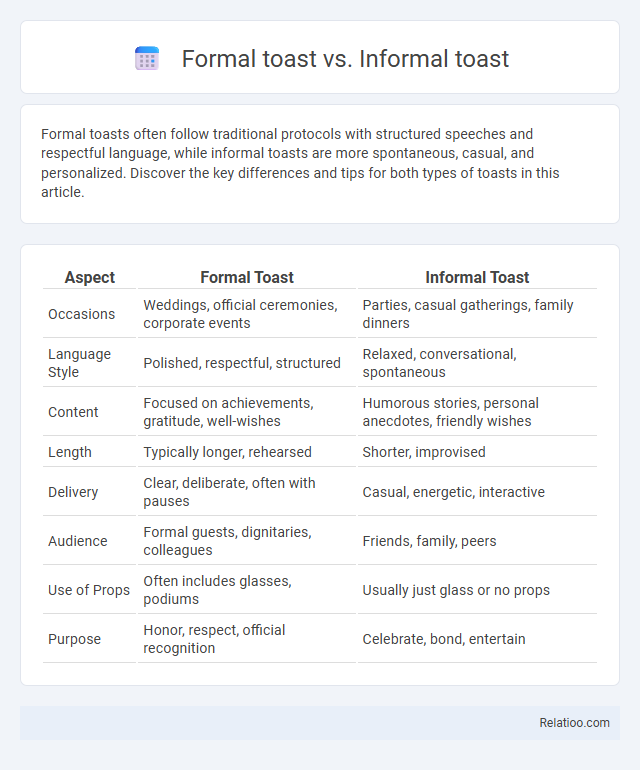Formal toasts often follow traditional protocols with structured speeches and respectful language, while informal toasts are more spontaneous, casual, and personalized. Discover the key differences and tips for both types of toasts in this article.
Table of Comparison
| Aspect | Formal Toast | Informal Toast |
|---|---|---|
| Occasions | Weddings, official ceremonies, corporate events | Parties, casual gatherings, family dinners |
| Language Style | Polished, respectful, structured | Relaxed, conversational, spontaneous |
| Content | Focused on achievements, gratitude, well-wishes | Humorous stories, personal anecdotes, friendly wishes |
| Length | Typically longer, rehearsed | Shorter, improvised |
| Delivery | Clear, deliberate, often with pauses | Casual, energetic, interactive |
| Audience | Formal guests, dignitaries, colleagues | Friends, family, peers |
| Use of Props | Often includes glasses, podiums | Usually just glass or no props |
| Purpose | Honor, respect, official recognition | Celebrate, bond, entertain |
Understanding the Concept of Toasts
Formal toasts are structured expressions of goodwill or celebration often delivered during ceremonies, weddings, or official events, emphasizing etiquette and tradition. Informal toasts occur in casual settings among friends or family, characterized by spontaneous, heartfelt messages without strict rules. Understanding the concept of toasts involves recognizing their role as social rituals that foster connection, convey respect or celebration, and vary contextually based on the formality and purpose of the occasion.
Key Differences Between Formal and Informal Toasts
Formal toasts follow structured etiquette, often delivered with prepared speeches, emphasizing respect, tradition, and specific occasions like weddings or official events. Informal toasts are spontaneous, relaxed, and conversational, commonly made among friends or family during casual gatherings. The key difference lies in tone, context, and purpose: formal toasts prioritize ceremony and decorum, whereas informal toasts focus on camaraderie and personal connection.
Occasions for Formal Toasts
Formal toasts are typically reserved for significant occasions such as weddings, corporate events, and official ceremonies, where tradition and etiquette guide the speech structure. Informal toasts are more relaxed, common at casual gatherings like birthdays or friendly get-togethers, allowing for a more spontaneous and personal tone. Your choice between formal and informal toast depends on the occasion's level of formality and the audience, ensuring your message is appropriate and well-received.
Situations Suitable for Informal Toasts
Informal toasts are best suited for casual gatherings such as family dinners, friendly parties, and relaxed celebrations where the atmosphere is light and personal connections are emphasized. Unlike formal toasts, which require structured speeches and polite language suited for weddings or corporate events, informal toasts embrace spontaneity and humor, making them ideal for birthdays or small social occasions. The key to effective informal toasting lies in sincerity, brevity, and a tone that reflects the warmth and familiarity of the group.
Structure of a Formal Toast
A formal toast follows a specific structure, beginning with a clear introduction that identifies the occasion and key individuals involved, followed by a heartfelt message that reflects the purpose of the gathering. It typically includes a well-organized flow with respectful language, concise points, and a strong conclusion that calls for raising glasses. Your understanding of this structure helps ensure the toast is memorable and appropriate for the setting, distinguishing it clearly from informal toasts that are more casual and spontaneous.
Elements of an Informal Toast
Informal toasts typically include a casual greeting, a heartfelt or humorous message, and a simple closing that invites everyone to raise their glasses, distinguishing them from formal toasts which follow strict protocols and ceremonial language. Your informal toast often embraces personal stories and spontaneous expressions that foster warmth and connection among guests. Key elements include sincerity, brevity, and an inclusive tone that encourages participation without the need for elaborate structure.
Etiquette and Protocol in Formal Toasts
Formal toasts follow strict etiquette and protocol, often requiring precise wording, respectful tone, and a clear, deliberate delivery to honor the occasion and attendees. Informal toasts are more relaxed, allowing spontaneous, personalized remarks without rigid structure or ceremonial expectations. The general concept of a toast involves raising a glass to recognize a person, event, or achievement, but formal toasts emphasize decorum, timing, and adherence to social customs for proper recognition and respect.
Language and Tone: Formal vs Informal Toasts
Formal toasts use polished, respectful language reflecting traditional etiquette, with a serious and dignified tone often reserved for ceremonies or official events. Informal toasts embrace casual, relaxed language filled with humor and personal anecdotes, fostering a warm and friendly atmosphere at gatherings of close friends or family. The tone of a toast determines its impact, where formal settings demand elevated diction and measured delivery, while informal settings welcome spontaneous, heartfelt expressions.
Common Mistakes to Avoid in Both Toast Types
Common mistakes to avoid in both formal and informal toasts include overlong speeches that lose the audience's attention and failing to tailor your message to the occasion. You should avoid using inappropriate humor or controversial topics that might offend guests regardless of the setting. Ensuring your toast is clear, concise, and respectful will enhance your delivery and positively impact your audience.
Choosing the Right Toast for the Event
Choosing the right toast for your event depends on the tone and formality desired: formal toasts often include structured speeches with respectful language ideal for weddings or corporate gatherings. Informal toasts are more casual, personal, and spontaneous, fitting for friendly get-togethers or family celebrations. Your choice should reflect the audience and occasion to create an engaging and appropriate moment of acknowledgment.

Infographic: Formal toast vs Informal toast
 relatioo.com
relatioo.com